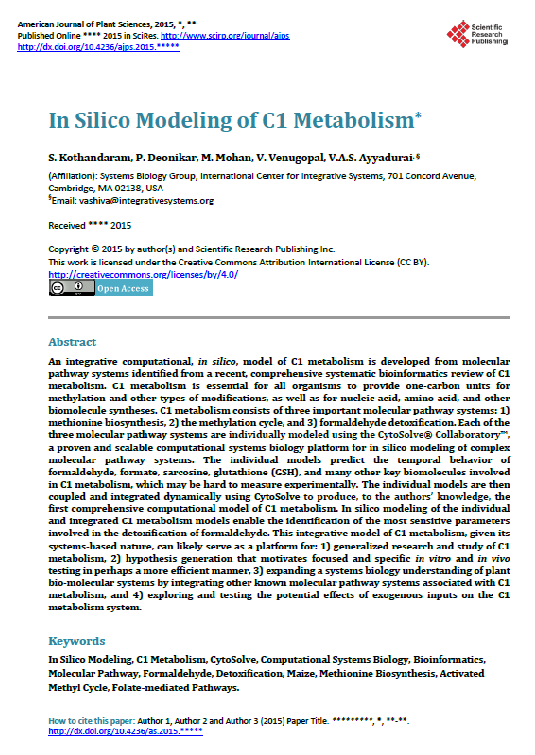In Silico Modeling of C1 Metabolism
S. Kothandaram, P. Deonikar, M. Mohan, V. Venugopal, V.A.S. Ayyadurai
American Journal of Plant Sciences, 2015
http://dx.doi.org/10.4236/ajps.2015
An integrative computational, in silico, model of C1 metabolism is developed from molecular pathway systems identified from a recent, comprehensive systematic bioinformatics review of C1 metabolism. C1 metabolism is essential for all organisms to provide one-carbon units for methylation and other types of modifications, as well as for nucleic acid, amino acid, and other biomolecule syntheses. C1 metabolism consists of three important molecular pathway systems: 1) methionine biosynthesis, 2) the methylation cycle, and 3) formaldehyde detoxification. Each of the three molecular pathway systems are individually modeled using the CytoSolve® Collaboratory™, a proven and scalable computational systems biology platform for in silico modeling of complex molecular pathway systems. The individual models predict the temporal behavior of formaldehyde, formate, sarcosine, glutathione (GSH), and many other key biomolecules involved in C1 metabolism, which may be hard to measure experimentally. The individual models are then coupled and integrated dynamically using CytoSolve to produce, to the authors’ knowledge, the first comprehensive computational model of C1 metabolism. In silico modeling of the individual and integrated C1 metabolism models enable the identification of the most sensitive parameters involved in the detoxification of formaldehyde. This integrative model of C1 metabolism, given its systems-based nature, can likely serve as a platform for: 1) generalized research and study of C1 metabolism, 2) hypothesis generation that motivates focused and specific in vitro and in vivo testing in perhaps a more efficient manner, 3) expanding a systems biology understanding of plant bio-molecular systems by integrating other known molecular pathway systems associated with C1 metabolism, and 4) exploring and testing the potential effects of exogenous inputs on the C1 metabolism system.

